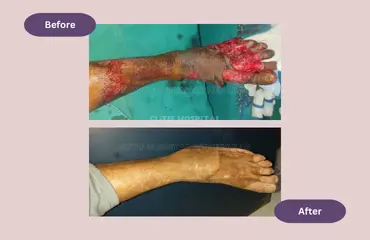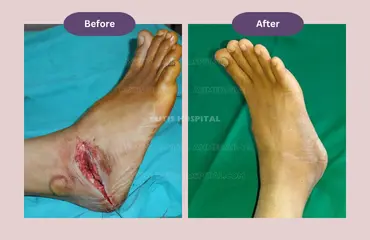Compound lower limb fractures are one of the most frequent of all lower limb injuries. In these injuries of lower limbs, fracture of the bone is associated with varying degrees of injury of skin overlying the fracture site. Due to high velocity, powerful two wheelers and increasing traffic congestion, many trivial looking two-wheeler accidents lead to different varieties of compound lower limb injuries. Apart from two-wheeler accidents, run over accidents, car accidents and industrial accidents also account for significant number of compound lower limb injuries.
The common factor responsible for uncomplicated healing and excellent long-term outcome of such compound lower limb injuries is involvement of a qualified and experienced plastic surgeon in the treatment of such injuries from the very beginning. At Cutis hospital, we follow the same principle and all patients of compound lower limb injuries are examined and admitted under the care of our plastic surgeon. Plan of management of the patient is discussed and formed after joint examination and consultation of the patient by our plastic surgeon and orthopedic surgeon.
Symptoms of compound lower limb fractures are no different from routine fractures. Pain, swelling, deformity of limb, and inability to walk are the common fracture symptoms and variable degree of injury of skin and soft tissue structures overlying the fracture site is the additional symptom of a compound fracture. The severity of this skin and soft tissue injury overlying the fracture site and its impact on fracture healing and the final result can only be assessed by a plastic surgeon.
The causes of compound lower limb fractures are mainly road traffic accidents and industrial accidents. Among road traffic accidents, two-wheeler accidents happening within city traffic or on highways account for many injuries. While car accidents account for most of the cases, Car accidents can be associated with injuries to other body parts; in that scenario, the patient is having a polytrauma, and the priority of management changes sometimes. Industrial accidents also account for complex lower limb fractures, though less in number than road traffic accidents.
Diagnosis of these complex lower limb injuries is not very difficult. Thorough clinical examination and basic radiological investigation like X – ray of injured extremity is sufficient for diagnosis in most cases. However, sophisticated diagnostic modalities like CT scan, MRI, color Doppler, or angiography are needed in some difficult situations.
Treatment of compound lower limb injury patient starts from joint examination of the patient by a plastic surgeon and an orthopedic surgeon. Formulation of a comprehensive management plan before any surgery is done is the most important aspect of treatment. Many of these patients are having comminution (multiple pieces) of fracture fragments, bone loss of variable degree, loss of overlying soft tissues to variable extent and associated co morbid conditions like old age, diabetes, atherosclerosis etc. In such situations, formulation of a comprehensive plan of management by plastic surgeon and orthopedic surgeon and counselling of the patient and his/her relatives about this comprehensive plan is extremely important. Most if not all, of these patients need multiple surgeries. Precise planning and perfect execution of all stages of surgeries according to the comprehensive management plan is the essential prerequisite for successful outcome. Such patients require initial stabilization of the fracture fragment (which might be temporary) along with thorough debridement of the wound and detailed assessment of the tissue losses.
After 48 to 72 hours of primary surgery, re-look debridement surgery along with definitive fracture fixation is planned and executed. Coverage/replacement of soft tissue losses may or may not be combined with fracture fixation and it can be deferred for few days after the fracture fixation. Continuous monitoring of patient’s general condition, his limb condition, development of signs of infection, changes in laboratory tests and all other aspects is vigilantly made till the last stages of healing process is completed which might last up to 2 months of period.
This sequence of management is not always the norm. Definitive fracture fixation can readily be performed during the stage of primary (first) surgery along with debridement performed by a plastic surgeon. But, after definitive fracture fixation is performed during primary surgery, wound cover and all soft tissue healing must be ensured quickly and effectively to prevent secondary infection of bone or implant. Thus, the management of compound lower limb fractures is an extremely complex, intricate, difficult and risky task.
To accomplish this task successfully, patient must be treated by a coordinated and finely orchestrated tuning with combined approach of a plastic surgeon and an orthopedic surgeon from the moment patient arrives in the hospital till he joins his work. And patient must arrive the hospital preferably within 6 hours of the accident.
The most common and undesirable complication of compound fractures of lower limb is infection of the bone called osteomyelitis. Apart from infection of bone, other such difficult complications include non-union of fracture, infection at the fracture site, exposure of implant, exposure of bone/fracture site, infection of soft tissues (cellulitis) and chronic edema (swelling) of whole lower limb which can turn in to chronic lymph edema. As mentioned earlier, proper planning of the treatment of these injuries from the beginning by a team of plastic surgeon and orthopedic surgeon and perfect execution of the planned treatment along with close follow up of healing process through out the course of treatment till the patient becomes incorporated in his life is the best and only way to avoid/minimize the complications of compound fracture treatment.
As majority of these injuries happen due to road traffic accidents, religiously following all traffic safety rules is the best method of prevention. However, once the injury happens, shifting the patient to a proper place where combined approach of plastic surgery and orthopedic surgery is available is the best way to prevent serious complications and expedite the healing.
Results of treatment of compound lower limb fractures are good to excellent provided the treatment proceeds the ideal way of combined approach of a plastic surgeon and an orthopedic surgeon (as described earlier) from immediately after the accident. Many unfortunate patients are not aware about this scientific fact and they end up with the treatment which is centred only on fracture fixation with complete disregard towards management of associated soft tissue injuries. This does not result only in soft tissue complications, but this ignorance of associated soft tissue injuries in a case of compound lower limb bone fractures defies the purpose of fracture fixation and most commonly end up with infection of the bone/fracture site and repeated episodes of infection necessitating removal/replacement of implants, additional bone grafting procedures, high magnitude reconstructive surgeries and above all; compromised functional result after exhausting the patient of time, energy and money.
At Cutis Hospital, we follow the best-established protocols for the management of lower limb compound fractures. Our team of experienced plastic surgeons and orthopedic surgeons has excellent coordination and experience in dealing with such injuries. All management protocols are established right from the presentation of the patient to the emergency department of Cutis Hospital, and treatment is started without delay. The patient and his/her relatives are explained and counselled about the problem and its solution.
Not only surgical details, but also an estimate of the average hospital stay, expenses, ancillary treatments, and rehabilitation program are given even before the first surgery. Uncertainties during the treatment and alternative plans to manage them are also explained. In all, our dedicated and expert team of plastic surgeons and orthopedic surgeons efficiently handles all cases of compound lower limb fractures.



Patients with compound lower limb fractures must be transferred to a setup where the skills of an experienced plastic surgeon and orthopedic surgeon are available along with 24 X 7 availability of a plastic surgeon.
Absolutely, no. In fact, the presence of a plastic surgeon is not only important, it is vital. Right from the presentation of the patient in the emergency room, till complete rehabilitation is achieved in all cases of compound lower limb fractures, a plastic surgeon’s presence is essential. Fracture fixation is a one-time phenomenon while dressing and management of soft tissues is a constant process and needs to be done on a daily basis.
Yes. In fact, amputation or salvage or partial amputation of any extremity must be done by or in the presence of a plastic surgeon only. Because plastic surgery is the discipline involved with the functionality of tissues, the decision about the level of amputation and its perfect execution is best achieved by a plastic surgeon.
Patients with compound lower limb injuries undergo multiple surgeries and prolonged bed rest. Despite closed observation and follow-up, some of these patients develop secondary complications like stiffness of joints, contractures, hypertrophic scars, and chronic edema. Most of these complications respond to consistent and supervised rehabilitation programs. So, all the patients of compound lower limb fractures must follow up till their rehabilitation is completed and they are back in their lives.
Yes. Though this is a difficult clinical scenario, with the combined team approach of a plastic surgeon, orthopedic surgeon, and vascular surgeon such complex injuries can be tackled and accomplished. However, vascular repair and subsequent ischemia-reperfusion injury is a major concern and needs to be explained and discussed in detail.
Cutis Hospital is conveniently located in Ghatlodia, Ahmedabad, making it easily accessible via multiple modes of transportation. Below are the various ways you can reach our facility:
Sardar Vallabhbhai Patel International Airport: Located approximately 12.7 km from Cutis Hospital, offering convenient access for patients traveling from outside the city.
Chandlodiya Railway Station: Approximately 2.4 km from Cutis Hospital.
Ahmedabad Railway Station: Around 11 km from our center.
GSRTC:
Ahmedabad Central Bus Station (GSRTC): About 10.3 km from the hospital.
AMTS:
Bhuyangdev Cross Road Bus Stop: Just 500 meters from Cutis Hospital.
BRTS:
Bhuyangdev BRTS Bus Stop: Only 170 meters from our center.
We provide effective surgical and non-surgical treatments for all parts of the body. At Cutis Hospital, our cosmetic and plastic surgery team is committed to giving patients safe and high-quality care.